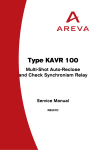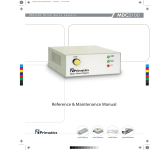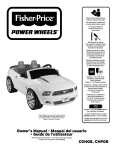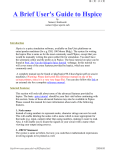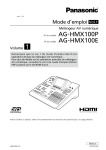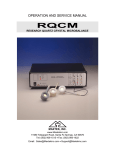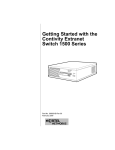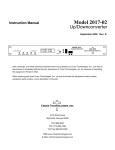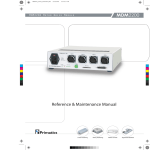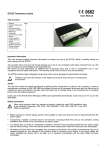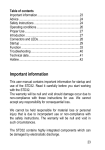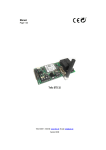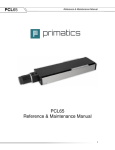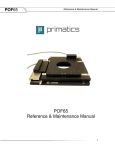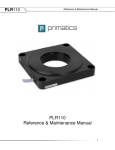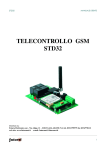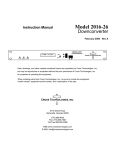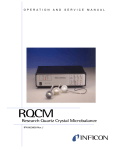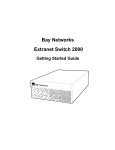Download MDC Family
Transcript
mdc14_1800_cover.pdf 10/30/2006 1:49:32 PM MDC Family MDC Family Motor Drive Chassis S E R I E S C M Y CM MY CY CMY K MDC1400 & MDC1800 Reference & Maintenance Manual Linear Positioning Rotary Positioning Motion Controls Engineered Solutions Reference & Maintenance Manual 32114 Mallard Ave. PO Box 409 Tangent, OR 97389-0409 U.S.A. Phone: Fax: Toll Free: Web: E-mail: [541] 791-9678 [541] 791-9410 [888] 754-3111 www.primatics.com [email protected] MDC1400 & MDC1800 Manual Revision Information Publication Date October 2003 July 2004 April 2005 August 2005 January 2006 November 2006 June 2007 October 2007 March 2008 Notes First Release Correct Formatting and Typos Updated Look & Formatting Correct errors for MDC1800 and I/O Revised Table 6-4 Updated Chassis Dimensions Updated Figure 6-5, Added Programming Port Table Added Motion Control Card connection section Incorporated Aux Encoders into Section 8.1 Notice: Any descriptions, drawings, and specifications contained herein are subject to change. Primatics is not responsible for errors or omissions herein or for incidental damages in connection with the furnishing or use of this information. This document shall not be reproduced, photocopied, or duplicated, in whole or in part, without prior written approval of Primatics Corporation. For additional specifications, dimensioned drawings and additional information, refer to the MDC1400 & MDC1800 Datasheets available from our website at www.primatics.com. ©Copyright 2007-2008 by Primatics, Inc; All Rights Reserved. Primatics, the Primatics logo, PrimaFlex, PrimaSeal & SimpleMatch are trademarks of Primatics, Inc. 1 Reference & Maintenance Manual MDC1400 & MDC1800 Manual Revision Information .................... 1 1) Overview ....................................................................................... 4 2) Introduction – About the MDC1400 & MDC1800........................ 5 3) Model Configuration .................................................................... 6 3.1) MDC1400........................................................................................................................................ 6 3.2) MDC1800........................................................................................................................................ 7 4) Personal Safety ................................................................ 8 5) Installation .................................................................................... 9 5.1) Locating the MDC........................................................................................................................... 9 5.2) Front Panel Indicators and Controls .............................................................................................. 11 5.3) Rear Panel Information ................................................................................................................. 12 5.3.1) The Safety Port........................................................................................................................... 13 6) Connecting Motors to the MDC................................................. 15 6.1) D1 option: Brushless servo motor, trapezoidal drive .................................................................... 16 6.1.1) Brushless Servo Mating Connector Information ........................................................................ 18 6.2) D3 option: Brush servo motor motors ........................................................................................... 19 6.2.1) Brush Servo Mating Connector Information .............................................................................. 21 6.3) D4 option: Step Motor................................................................................................................... 22 6.3.1) Step Mating Connector Information........................................................................................... 26 6.4) D7 option: Brushless motor, digital drive ..................................................................................... 27 6.4.1) Brushless Servo Mating Connector Information ........................................................................ 29 6.5) D9 option: User Axis..................................................................................................................... 30 7) Operations .................................................................................. 31 7.1) Fault Detection and Motor Power Control .................................................................................... 31 7.2) Axis Card Indicators...................................................................................................................... 32 7.3) Motor Output Signals .................................................................................................................... 32 7.3.1) Brushless Servo Motor ............................................................................................................... 32 7.3.2) Step Motor.................................................................................................................................. 33 7.4) Encoder Input ................................................................................................................................ 33 7.5) Limit, Home & Temp Sensors ...................................................................................................... 34 7.6) Brake Release Output.................................................................................................................... 34 8) The Galil DMC 21x3 .................................................................... 35 8.1) DMC 21x3 Connectors for the MDC1400 .................................................................................... 35 8.1.1) Communication Ports: RS-232, Ethernet ................................................................................... 35 8.1.2) The I / O Port.............................................................................................................................. 36 8.1.3) Auxiliary Encoder Input............................................................................................................. 37 8.1.4) External I / O Port (Optional)..................................................................................................... 38 8.2) DMC 21x3 Connectors for the MDC1800 .................................................................................... 39 8.2.1) Communication Ports: RS-232, Ethernet ................................................................................... 39 8.2.2) I / O Ports ................................................................................................................................... 40 8.2.2) Auxiliary Encoder Input............................................................................................................. 42 8.3) Overview ....................................................................................................................................... 44 2 Reference & Maintenance Manual 8.3.1) MDC Digital Inputs and Outputs ............................................................................................... 44 8.3.2) Encoder Index Signals................................................................................................................ 45 8.4) The MDCOptima Application Programming Interface................................................................. 46 8.4.1) The API ...................................................................................................................................... 46 8.4.2) Motor Power Control ................................................................................................................. 46 8.4.3) Brakes......................................................................................................................................... 47 8.4.4) Latching the Encoder Index Pulse.............................................................................................. 48 8.4.5) User Inputs ................................................................................................................................. 48 8.5) Software Installation ..................................................................................................................... 49 8.5.1) Set the Controller Parameters..................................................................................................... 49 8.5.2) Setting Motion Control Parameters for each axis....................................................................... 49 8.5.3) Loading the API ......................................................................................................................... 49 8.5.4) Example 1 – Brushless Servo - Trapezoidal Drive.................................................................... 49 8.6) Appendices.................................................................................................................................... 51 8.6.1) Appendix A – MDCOptima API................................................................................................ 51 9) Troubleshooting & Service........................................................ 54 9.1) Removing a Card........................................................................................................................... 54 9.2) Troubleshooting Help.................................................................................................................... 57 9.3) Service........................................................................................................................................... 57 3 Reference & Maintenance Manual 1) Overview This user guide is designed to help you install and maintain your MDC Series motion control. Follow these steps to ensure correct installation and maximum life: Step 1 Review this entire user manual. Become familiar with all installation procedures prior to integrating your system. Step 2 Review the safety summary to develop an understanding of standard safety practices when installing and operating automated equipment. Step 3 Review installation procedures. For best results, follow these procedures carefully. 4 Reference & Maintenance Manual 2) Introduction – About the MDC1400 & MDC1800 This manual is intended for use by application engineers and technicians involved with Primatics positioning equipment. The MDC1400 and MDC1800 Series Motor Drive Chassis are programmable multi-axis motion controllers. They are modular system that package motor drivers, encoder interfaces, power supplies and safety systems into a single chassis. A Galil DMC-21x3 Series Motion Control Card is integrated into the Chassis. Third party positioning stages or axes can be operated from a properly configured MDC. A variety of cable assemblies are available to connect a positioning stage or axis to the MDC. The integrated Galil DMC-21x3 programmable motion control card makes the MDC1400/1800 a powerful element in a motion control system. DMC-21x3 can be programmed via its integrated RS-232 or Ethernet connection. The controller can be operated as a peripheral to the User’s host computer or as a stand alone system using its internal program memory storage capability. The Galil DMC-21x3 is a multitasking, multi-axis, high performance motion controller. Refer to the Galil DMC-21x3 programming and users manuals for more information. Note that the “x” in the Galil nomenclature stands for the number of axes available for use. There are two basic versions of the MDC1400/1800: MDC1400 for 1 to 4 drive axes in a 3U chassis MDC1800 for 1 to 8 drive axes in a 6U chassis The basic MDC models are configured with a motor power supply, motion controller and motor drives. They can support a mix of servo and stepper drives in one package. Refer to the Model Configurations on the following pages for more information. Custom versions of the MDC are also available to meet specific application needs including versions without an integrated programmable motion controller. Addendums to this manual will be included for custom configurations. 5 Reference & Maintenance Manual 3) Model Configuration 3.1) MDC1400 6 Reference & Maintenance Manual 3.2) MDC1800 7 Reference & Maintenance Manual 4) Personal Safety Please review before installing your motion system Observe common industrial safety practices when installing and operating automated equipment. o Have power connections made by qualified personnel. o Keep fingers and other items out of any opening in the stage while it is in operation since injury or damage may result. o Provide a safe access route and adequate room for servicing. o Perform the recommended periodic maintenance described in this document. o Verify that the work envelope is free of obstructions before the positioning stage is powered. o Insure that for servo motors the encoder must be working properly and the polarity of the encoder needs to match the polarity of the motor before enabling the servo drive. Improper feedback connections can cause a motor run-away condition that has the potential to damage the stage and injure an operator. o Only trained operators of the positioning stage should be allowed near the work environment. o Identify emergency stop circuits and actuators in the workcell. In an emergency press the yellow stop button on the drive chassis front panel. This cuts power to all axes amplifiers. o Note the places in the workcell where pinch points occur, and provide adequate safety clearance or safety curtain. o Never operate the motor in a location that could be splashed by water, exposed to corrosive or flammable gases or is near combustible substances since this may cause an electric shock, fire or malfunction. o Never touch the motor, driver, or peripheral devices when the power is on or immediately after the power is turned off. The high temperature of these parts may cause burns. 8 Reference & Maintenance Manual 5) Installation 5.1) Locating the MDC A typical motion system consists of the MDC, axis cables and positioning stages. The Motion Controller Card is housed inside the MDC. The MDC also includes Motor Drive Cards for each axis of travel; these Motor Drive Cards connect to stages with axis cables. Figure 5-1 shows a typical system using the MDC1400. Figure 5-1: MDC1400 Motion System The MDC must be placed in a convenient location for connection to both the motion control card and your stages. Access to the front panel controls and the rear panel connectors must be considered before installation. There are no user serviceable parts in the chassis, but axis cards are “plug-in” assemblies that can be removed and installed from the rear of the chassis. Both desktop and rack mount model dimensions can be found in Figure 5-2. The rack mount chassis includes mounting flanges for securing the chassis in an equipment rack. 9 Reference & Maintenance Manual MDC1800 MDC1400 Figure 5-2: Dimensions of MDC 10 Reference & Maintenance Manual 5.2) Front Panel Indicators and Controls Figure 5-3: Front Panel SYSTEM POWER is illuminated whenever power is applied to the chassis, and the power switch on the rear is turned on. MOTOR POWER is illuminated when the internal motor power supply is turned on. FAULT is illuminated whenever any condition exists that prevents the motor power supply to be turned on. STOP is connected into the Safety Port on the rear panel described in Section 5.3.1. CB1 is a circuit breaker for the input to the motor power supply. CB2 is a circuit breaker for the output of the motor power supply. 11 Reference & Maintenance Manual 5.3) Rear Panel Information All connections to the MDC are made at the Rear Panel. Figures 5-4 and 5-5 show the Rear Panel views of a typical MDC1400 & MDC1800, respectively. Note that the Motor Drive Cards (Axis Cards) are identified as Axes 1 through 8. The Galil Motion Controller will associate the drive card in Axis 1 with Galil Axis A, the drive card in Axis 2 with Galil Axis B, and so on. Figure 5-4: Axis Cards and Motion Control Card Association in MDC1400 Figure 5-5: Axis Cards and Motion Control Card Association in MDC1800 12 Reference & Maintenance Manual 5.3.1) The Safety Port At the rear of the MDC is a pluggable terminal strip labeled Safety Port (see Figure 5-6). The Safety Port has two functions: connecting the MDC into the safety system of an application (Stop Loop) and interlocking the safety circuits in multiple MDC systems (Fault Bus). Figure 5-6: Safety Port 5.3.1.1) Stop Loop and Stop Switch To enhance the safety of an application, the motor power supply in the MDC uses an external Stop Loop to control the state of its motor power circuit. For normal operation of the motor power supply, the Stop Loop found on pins 3 and 4 of the Safety Port must form a closed circuit. An open Stop Loop will generate internal STOP and hardware faults, killing power to the motors. The Stop Switch on the front panel of the MDC chassis is a normally closed switch connected between pins 1 and 2 of the Safety Port. If no external devices are to be connected to the Stop Loop, the Stop Switch must be connected as shown in Figure 5-7. 13 Reference & Maintenance Manual Figure 5-7: Stop Switch and Stop Loop connections (pins 1, 2, 3 and 4 of Safety Port) To connect the MDC safety system to external devices, such as an external STOP switch, light curtain, etc, insert the normally closed circuit from the safety devices into one of the two loops show in Figure 5-7. Assure that the safety circuit is a dry contact. 5.3.1.2) Fault Bus The Fault Bus is used to propagate internal hardware faults from one MDC to another. A multiple MDC system can use the Fault Bus on pins 5 and 6 of the Safety Port to connect the safety systems between MDC chassis. In such a system, connect the Fault Buses as shown in Figure 5-8. When multiple MDCs are connected to the Fault Bus, an ESTOP or other hardware faults in one MDC will cause a hardware fault in all other MDCs on the bus. Up to four MDCs can be connected with the Fault Bus. Single MDC systems have no connection to the Fault Bus. Figure 5-8: Fault Bus Connections (pins 5 & 6 of Safety Port) 14 Reference & Maintenance Manual 6) Connecting Motors to the MDC IMPORTANT ALL CONNECTIONS ARE TO BE MADE WITH NO POWER APPLIED TO THE MDC This section contains information about all of the drive card options. It includes pin-outs of the cable connectors on each card as well as specifications. Note that some of the information may not apply to your specific MDC. An axis consists of a motor, encoder, forward limit, reverse limit, home sensor, and motor temperature switch. All servo axes require encoder feedback. For step axes this feedback is optional. Different drive options are available for various motor types. Table 6-1 lists the standard drive options and a description of the drive. Table 6-1: Drive Options Option D1 D3 D4 D7 D9 Drive Type Brushless Servo, Trapezoidal Brushed Servo Mircrostepping, Brushless Servo, Digital Sinusoidal User Axis Amps 6A Cont, 12A Peak Voltage 20-85 V 6A Cont, 12A Peak 5A RMS, 7A Peak 3A Cont, 9A Peak 20-85V 24-75V 20-85V - - Connector Brushless Servo Brush Servo Stepper Brushless Servo User Axis Section 6.2 6.3 6.4 6.5 6.6 The following sections describe the connection for the different drive types. 15 Reference & Maintenance Manual 6.1) D1 option: Brushless servo motor, trapezoidal drive The D1 option is for brushless servo motors that are commutated with hall sensors (trapezoidal commutation). Specifications: Motor Type Drive Type Current Voltage Min Load Inductance Bandwidth Connector Fuse Brushless servo with commutation (hall) sensors PWM. 33 kHz 6A cont / 12A peak 20-80 VDC 200 µH 2.5 kHz Servo Brushless Axis 6A SB 5x20mm Figure 6-1) Brushless Motor, Trapezoidal Card 16 Reference & Maintenance Manual Table 6-2) Brushless Servo Axis Connector Pin-out Pin A B C D E F G H J K L M N P R S T U V W X Y Z a b c d e Name MOT A MOT B MOT C MOT SHLD ENC 5V ENC A+ ENC AENC B+ ENC BENC SHLD LIMIT 12V LIMIT COM HOME BRAKE+ BRAKESHIELD HALL 5V HALL 0V ENC 0V ENC I+ ENC IFLS RLS <key> HALL A HALL B TEMP HALL C Function Motor phase A Motor phase B Motor phase C Shield for motor signals, connect to motor case. Encoder power supply, 5VDC Encoder channel A+ Encoder channel AEncoder channel B+ Encoder channel BShield for encoder signals, connect to encoder case. 12VDC Power supply for home and limit sensors, switchable to 5V power supply return for home and limit sensors. Home signal input Failsafe brake power output, 24VDC to release brake return for brake power output Shield for cable Hall sensor power output, 5VDC return for Hall sensor power output Return for Encoder power Encoder channel I+ Encoder channel IForward limit switch input. Reverse limit switch input. Hall sensor A input Hall sensor B input Motor temperature switch input. Connect to LIMIT COM for normal operation. Hall sensor C input 17 Reference & Maintenance Manual 6.1.1) Brushless Servo Mating Connector Information Connector Parts: Manufacturer: ITT Cannon. Similar parts also available from FCI: Description Connector Body: Connector Body, cable mount, 28 pins Backshell Contacts: Pins, crimp, 26-24 AWG Pins, crimp, 22-20 AWG Pins, crimp, 18-16 AWG Pins, crimp, 16-14 AWG Pins, solder cup Keying pin Hand Assembly Tools: Extraction Tool Crimp Tool, ratcheted Crimp Tool, low cost, low volume Cannon P/N Remark 192922-1290 192922-1350 Mates with panel mount, 28 sockets Use with any connector body 192990-0020 192990-0040 192990-0060 192990-1240 192900-0632 192990-0000 Use with Crimp Tool Use with Crimp Tool Use with Crimp Tool Use with Crimp Tool Solder to conductors up to 14 AWG Use in position ‘a’ for sevo axes 192922-1450 112108-0014 192922-1440 Used with all contacts Used with crimp contacts 26-16 AWG Used with crimp contacts 26-14 AWG Connector Kits: Kit Model Connection Kit 28-Position Pin Cable Connection Tool Kit – Crimp and Extraction Remark Primatics P/N 0-3064-1300 which consists of: 1 cable mount connector body for pins 1 backshell 5 crimp pins 16-18 AWG 30 crimp pins 20-22 AWG 1 keying pin Primatics P/N 0-3064-1400 which consists of: 1 extraction tool 1 crimp tool (low cost, low volume) Used with any of the contacts in the kits listed. Only one kit required per user and tools can be reused on many connectors Cable Assemblies: CABLE-SERVO-MDC-STAGE to connect MDC to Primatics Servo Axis CABLE-SERVO-MDC-PIGTAIL to connect MDC to User Supplied Servo Axis 18 Reference & Maintenance Manual 6.2) D3 option: Brush servo motor motors The D3 option is for brush servo motors Specifications: Motor Type Drive Type Current Current Voltage Min Load Inductance Bandwidth Connector Fuse Brush DC Servo PWM. 33 kHz 6A cont / 12A peak 20-80 VDC 200 µH 2.5 kHz Servo Brushless Axis 6A SB 5x20mm Figure 6-2) Brush Motor Card 19 Reference & Maintenance Manual Table 6-3) Brush Servo Axis Connector Pin-out Pin A B C D E F G H J K L M N P R S T U V W X Y Z a b c d e Name MOT A MOT B not used MOT SHLD ENC 5V ENC A+ ENC AENC B+ ENC BENC SHLD LIMIT 12V LIMIT COM HOME BRAKE+ BRAKESHIELD not used not used ENC 0V ENC I+ ENC IFLS RLS <key> not used not used TEMP not used Function Motor phase A Motor phase B Shield for motor signals, connect to motor case. Encoder power supply, 5VDC Encoder channel A+ Encoder channel AEncoder channel B+ Encoder channel BShield for encoder signals, connect to encoder case. 12VDC Power supply for home and limit sensors, switchable to 5V power supply return for home and limit sensors. Home signal input Failsafe brake power output, 24VDC to release brake return for brake power output Shield for cable Return for Encoder power Encoder channel I+ Encoder channel IForward limit switch input. Connect to LIMIT COM for normal operation. Reverse limit switch input. Connect to LIMIT COM for normal operation. Motor temperature switch input. Connect to LIMIT COM for normal operation. 20 Reference & Maintenance Manual 6.2.1) Brush Servo Mating Connector Information Connector Parts: Manufacturer: ITT Cannon. Similar parts also available from FCI: Description Connector Body: Connector Body, cable mount, 28 pins Backshell Contacts: Pins, crimp, 26-24 AWG Pins, crimp, 22-20 AWG Pins, crimp, 18-16 AWG Pins, crimp, 16-14 AWG Pins, solder cup Keying pin Hand Assembly Tools: Extraction Tool Crimp Tool, ratcheted Crimp Tool, low cost, low volume Cannon P/N Remark 192922-1290 192922-1350 Mates with panel mount, 28 sockets Use with any connector body 192990-0020 192990-0040 192990-0060 192990-1250 192900-0632 192990-0000 Use with Crimp Tool Use with Crimp Tool Use with Crimp Tool Use with Crimp Tool Solder to conductors up to 14 AWG Use in position ‘a’ for sevo axes 192922-1450 112108-0014 192992-1440 Used with all contacts Used with crimp contacts 26-14 AWG Used with crimp contacts 26-14 AWG Connector Kits: Kit Model Connection Kit 28-Position Pin Cable Connection Tool Kit – Crimp and Extraction Remark Primatics P/N 0-3064-1300 which consists of: 1 cable mount connector body for pins 1 backshell 5 crimp pins 16-18 AWG 30 crimp pins 20-22 AWG 1 keying pin Primatics P/N 0-3064-1400 which consists of: 1 extraction tool 1 crimp tool (low cost, low volume) Used with any of the contacts in the kits listed. Only one kit required per user and tools can be reused on many connectors Cable Assemblies: CABLE-SERVO-MDC-STAGE to connect MDC to Primatics Servo Axis CABLE-SERVO-MDC-PIGTAIL to connect MDC to User Supplied Servo Axis 21 Reference & Maintenance Manual 6.3) D4 option: Step Motor The D4 option is for step motor with encoder axis. There is a protective fuse located as shown below. The step motor driver can be configured for the number of steps per revolution of the motor. The configuration is set with a 4 bit DIP switch found on the motor driver. The motor driver is attached to the Step Driver card with 4 screws shown below. Specifications: Motor Type Drive Type Current Current Voltage Max Step Freq Microsteps / Revolution (1.8º Motor) Connector Fuse 2 phase step motor Microstepping, PWM 20 kHz 1.0 to 7A peak (max 5A RMS) 24 to 75 VDC 1.8 mHz 400, 800, 1000, 1600, 2000, 3200, 5000, 6400, 10000, 12800, 25000, 25600, 50000, 51200 Step Axis Connector 5A SB 5x20mm Figure 6-3) Microstepping, IMS 805 Stepper Card 22 Reference & Maintenance Manual Remove the screws and unplug the driver from the card. Turn the driver over and locate the DIP switch. Figure 6-4) DIP switch location on driver The step resolution is set with the switch according to the following table: Table 6-4) Step Driver Resolution Switch DIP switch bit 1 2 3 uSteps/Step uSteps/Rev for 1.8° motor 2 400 4 800 5 1000 8 1600 10 2000 16 3200 25 5000 32 6400 50 10000 64 12800 125 25000 128 25600 250 50000 256 51200 Bold = Factory Default 4 MSEL0 MSEL1 MSEL2 MSEL3 ON OFF ON ON OFF OFF ON ON OFF OFF ON ON OFF OFF ON ON ON OFF ON OFF OFF ON OFF ON ON OFF ON OFF ON ON ON ON ON ON ON OFF ON OFF OFF OFF OFF OFF ON ON OFF ON OFF ON OFF ON OFF ON OFF ON OFF ON After the card is configured, re-install the driver onto the card. Verify that the mounting screws are tight. Install the card into the MDC chassis. 23 Reference & Maintenance Manual Step Motor Drive Card - Current Adjustment Resistors The current for the step motor can be adjusted with a resistor on the Step Motor Drive card. The Drive card also features has a feature to reduce the current when a move is complete, thus reducing motor and driver heating when no motion is commanded. These currents are adjusted with two resistors on the board, R2 and R3. Let IRUN = peak running current and IHOLD = peak holding current. The resistors should have a power rating of 1/4W (or higher). Operating Current Adjustment The value of R2 is set for the desired operating current according to the following formula: R2 (Ohms) = IRUN X 500 where IRUN = 1.0A min, 7.0A max Current Reduction Resistor The value of R3 is set for the desired holding current according to the following formula: R3 (Ohms) = 500 X (IRUN x IHOLD) / (IRUN - IHOLD) where IHOLD = 0.5A min, 7.0A max Motor Inductance The Maximum motor inductance (mH per Phase) is determined by Max Inductance (mH per Phase) = 0.2 x Minimum Supply Voltage Motors whose inductance exceeds the computed value will have problems moving at high speed. 24 Reference & Maintenance Manual Table 6-5) Step Axis Connector Pin-out Pin A B C D E F G H J K L M N P R S T U V W X Y Name MOT A+ MOT B+ MOT B<key> ENC 5V ENC A+ ENC AENC B+ ENC BENC SHIELD 12VDC DCCOM HOME BRAKE+ BRAKECHASSIS MOT AMOT B COM ENC 0V ENC I+ ENC IFLS Z RLS a b c d MOT SHLD MOT A COM DCCOM TEMP e n/c Function Motor phase A+ Motor phase B+ Motor phase B Encoder 5V Encoder A+ Encoder AEncoder B+ Encoder BEncoder shield 12VDC Power supply for home and limit sensors, switchable to 5V power supply return for home and limit sensors. Home input. Connect to DCCOM to activate Fail-safe brake power output. 24VDC to release brake Fail-safe brake power return Chassis ground Motor phase A Motor Phase B common (no internal connection) Encoder power return Encoder Index+ Encoder Index Forward limit switch input. Must be connected to DCCOM for normal operation Reverse limit switch input. Must be connected to DCCOM for normal operation shield for motor cable Motor Phase A common (no internal connection) Power return for temperature sensor Temperature sensor input. Must be connected to DCCOM for normal operation no connection 25 Reference & Maintenance Manual 6.3.1) Step Mating Connector Information Connector Parts: Manufacturer: ITT Cannon. Similar parts also available from FCI: Description Connector Body: Connector Body, cable mount, 28 pins Backshell Contacts: Pins, crimp, 26-24 AWG Pins, crimp, 22-20 AWG Pins, crimp, 18-16 AWG Pins, crimp, 16-14 AWG Pins, solder cup Keying pin Hand Assembly Tools: Extraction Tool Crimp Tool, ratcheted Crimp Tool, low cost, low volume Cannon P/N Remark 192922-1290 192922-1350 Mates with panel mount, 28 sockets Use with any connector body 192990-0020 192990-0040 192990-0060 192990-1250 192900-0632 192990-0000 Use with Crimp Tool Use with Crimp Tool Use with Crimp Tool Use with Crimp Tool Solder to conductors up to 14 AWG Use in position ‘D’ for stepper axes 192922-1450 112108-0014 192992-1440 Used with all contacts Used with crimp contacts 26-14 AWG Used with crimp contacts 26-14 AWG Connector Kits: Kit Model Connection Kit 28-Position Pin Cable Connection Tool Kit – Crimp and Extraction Remark Primatics P/N 0-3064-1300 which consists of: 1 cable mount connector body for pins 1 backshell 5 crimp pins 16-18 AWG 30 crimp pins 20-22 AWG 1 keying pin Primatics P/N 0-3064-1400 which consists of: 1 extraction tool 1 crimp tool (low cost, low volume) Used with any of the contacts in the kits listed. Only one kit required per user and tools can be reused on many connectors Cable Assemblies: CABLE-STEP-MDC-STAGE to connect MDC to Primatics Step Axis CABLE-STEP-MDC-PIGTAIL to connect MDC to User Supplied Step Axis 26 Reference & Maintenance Manual 6.4) D7 option: Brushless motor, digital drive The D7 option is a digital drive for a brushless motor axis. The drive uses the hall switches and the encoder to sinusoidally commutate the drive. The drive must be programmed at the factory. There are no user configurable options for this card. Specifications: Motor Type Drive Type Current Current Voltage Bandwidth Connector Fuse Brushless servo with sinusoidal commutation PWM. 20 kHz 3A cont / 9A peak 20-90VDC 3.0 kHz Servo Brushless Axis 5A SB 5x20mm Figure 6-5) Brushless Motor, Digital Drive Card 27 Reference & Maintenance Manual Table 6-6) Brushless Servo Axis Connector Pin-out Pin A B C D E F G H J K L M N P R S T U V W X Y Z a b c d e Name MOT A MOT B MOT C MOT SHLD ENC 5V ENC A+ ENC AENC B+ ENC BENC SHLD LIMIT 12V LIMIT COM HOME BRAKE+ BRAKESHIELD HALL 5V HALL 0V ENC 0V ENC I+ ENC IFLS RLS <key> HALL A HALL B TEMP HALL C Function Motor phase A Motor phase B Motor phase C Shield for motor signals, connect to motor case. Encoder power supply, 5VDC Encoder channel A+ Encoder channel AEncoder channel B+ Encoder channel BShield for encoder signals, connect to encoder case. 12VDC Power supply for home and limit sensors, switchable to 5V power supply return for home and limit sensors. Home signal input Failsafe brake power output, 24VDC to release brake return for brake power output Shield for cable Hall sensor power output, 5VDC return for Hall sensor power output Return for Encoder power Encoder channel I+ Encoder channel IForward limit switch input. Reverse limit switch input. Hall sensor A input Hall sensor B input Motor temperature switch input. Connect to LIMIT COM for normal operation. Hall sensor C input Table 6-7) Programming Port / Encoder Output Pin 2 3 5 6 7 8 9 Name TxD RxD COM A+ AB+ B- Function RS232 transmit to Drive RS232 receive from Drive RS232 common Encoder output, channel A+ Encoder output, channel A Encoder output, channel B+ Encoder output, channel B - 28 Reference & Maintenance Manual 6.4.1) Brushless Servo Mating Connector Information Connector Parts: Manufacturer: ITT Cannon. Similar parts also available from FCI: Description Connector Body: Connector Body, cable mount, 28 pins Backshell Contacts: Pins, crimp, 26-24 AWG Pins, crimp, 22-20 AWG Pins, crimp, 18-16 AWG Pins, crimp, 16-14 AWG Pins, solder cup Keying pin Hand Assembly Tools: Extraction Tool Crimp Tool, ratcheted Crimp Tool, low cost, low volume Cannon P/N Remark 192922-1290 192922-1350 Mates with panel mount, 28 sockets Use with any connector body 192990-0020 192990-0040 192990-0060 192990-1240 192900-0632 192990-0000 Use with Crimp Tool Use with Crimp Tool Use with Crimp Tool Use with Crimp Tool Solder to conductors up to 14 AWG Use in position ‘a’ for sevo axes 192922-1450 112108-0014 192922-1440 Used with all contacts Used with crimp contacts 26-16 AWG Used with crimp contacts 26-14 AWG Connector Kits: Kit Model Connection Kit 28-Position Pin Cable Connection Tool Kit – Crimp and Extraction Remark Primatics P/N 0-3064-1300 which consists of: 1 cable mount connector body for pins 1 backshell 5 crimp pins 16-18 AWG 30 crimp pins 20-22 AWG 1 keying pin Primatics P/N 0-3064-1400 which consists of: 1 extraction tool 1 crimp tool (low cost, low volume) Used with any of the contacts in the kits listed. Only one kit required per user and tools can be reused on many connectors Cable Assemblies: CABLE-SERVO-MDC-STAGE to connect MDC to Primatics Servo Axis CABLE-SERVO-MDC-PIGTAIL to connect MDC to User Supplied Servo Axis 29 Reference & Maintenance Manual 6.5) D9 option: User Axis The User Axis card is used in place of an internal motor drive for connecting to an external drive or encoder. The signals from the attached motion controller are accessible on the Axis connector in Table 6-6. Table 6-8) User Axis Connector: DB25S Mate: DB25P Pin 1 2 3 4 5 6 7 8 9 10 11 12 13 14 15 16 17 18 19 20 21 22 23 24 25 Name ENC 5V ENC A+ ENC B+ ENC I+ FLS HOME CMDI STEP GROUND + 12V 24V VMOTOR CHASSIS GROUND ENC AENC BENC IRLS AMPENA GND DIR BRKREL GND 24R VMCOM Function Encoder power supply, 5VDC Encoder channel A+ Encoder channel B+ Encoder channel I+ Forward limit switch input. Connect to LIMIT COM for normal operation Home signal input Analog toque command output, -10 to +10V Step command output for Step Motors Failsafe brake release return +12VDC supply for external circuits 24VDC supply for external circuits Motor supply voltage Earth ground ENC 5V ground Encoder channel AEncoder channel BEncoder channel IReverse limit switch input. Connect to LIMIT COM for normal operation Amplifier enable output Reference for analog torque command Direction command output for step motors Brake release Reference for +12VDC supply Return for 24VDC supply Return for motor supply voltage 30 Reference & Maintenance Manual 7) Operations The operation and use of some features of the MDC are dependent on configuration. The operation of each drive axis is determined by the specific drive option selected. Similarly, the operation of the motion controller interface is determined by the specific version selected. However, there are many functions and features that are common to all versions and configurations including fault detection, motor power control, motor outputs, and sensor inputs. This section describes those features. 7.1) Fault Detection and Motor Power Control For the MDC, a fault is any condition that will prevent power from being applied to the motor drives. There are two DC power systems in the MDC chassis: the Logic supply and the Motor supply. The Logic supply provides DC power to all internal circuits as well as externally connected encoders, limit and home sensors, and optional brakes. The Logic supply is on anytime AC power is supplied and the power switch is on. This condition is indicated with the illumination of the SYSTEM POWER indicator on the front panel. The Motor supply provides the DC power to all of the motor drives. This power supply is on only if there are no fault conditions, and the motion controller has turned on the supply through its I/O signals. A fault condition will override the signals from the motion controller and turn off the motor supply. If a fault condition occurs, the source of the fault must be removed, and the condition must be re-set using I/O signals from the motion controller. The specific I/O signals and their operation are further explained in Section 8. A Fault condition is indicated by the illuminated FAULT indicator on the front panel. This condition is caused when any of the following occur: • • • System power turn-on. STOP LOOP on SAFETY PORT is open. Temperature switch input on any axis is open. The state of the Fault as well as the cause of the fault may be determined through input signals to the motion controller. 31 Reference & Maintenance Manual 7.2) Axis Card Indicators FORWARD LIMIT illuminated when Forward Limit Input is closed to DCCOM REVERSE LIMIT is illuminated when Reverse Limit Input is closed to DCCOM HOME SENSOR is illuminated when Home Input is closed to DCCOM TEMP SENSOR is illuminated when Temperature Input is closed to DCCOM AMP OK is illuminated when Drive is powered on, enabled, and has no faults. 7.3) Motor Output Signals 7.3.1) Brushless Servo Motor The brushless servo motor drives control current through the three phases of a brushless motor. For the D1 drive option, the motor is typically commutated with hall sensors or special encoder channels for this purpose. Figure 7.1 shows the timing diagram for the motor phases and commutation sensors. Figure 7-1: Motor commutation chart For the D7 digital drive, the motor is initially commutated by the hall sensors, but ultimately commutated by the encoder. This drive operates the motor in sinusoidal commutation which provides for smoother operation with lower torque and velocity ripple. 32 Reference & Maintenance Manual 7.3.2) Step Motor The step motor drive operates 2 phase, 4 wire step motors. Both 6-wire and 8-wire motors may be used with the drive, but must be connected in a 4 wire fashion. The step motor drive is capable of micro-stepping the motor up to 256 micro-steps per step. Figure 7-2 shows the timing of the step motor drive in half-step mode (2 micro-steps per step). Figure 7-2: Step motor phase timing diagram for positive motion 7.4) Encoder Input All drive card options have provision for incremental encoder position input. In the case of the servo motors, the encoder input is necessary to operate the motor. The use of the encoder input with the step motor drive is dependent on the configuration of the Galil. The encoder inputs are compatible with RS-422 differential signals commonly used on industrial encoders. Figure 7-3 shows the timing diagram for the encoder input. Figure 7-3: Encoder signal timing diagram for positive motion 33 Reference & Maintenance Manual 7.5) Limit, Home & Temp Sensors Each MDC compatible motion controller card supports monitoring a forward limit, reverse limit, and home sensor for each axis. The temperature switch input on each motor drive card exists to enhance the operational safety of an axis and is monitored by the Fault detection circuits discussed in Section 7.1. Figure 7-4 shows an equivalent schematic for the limit, home, and temperature inputs. Note that the MDC has a 12V supply available to power external sensor circuits. Figure 7-4: Sensor Input Circuit Diagram 7.6) Brake Release Output Each drive card includes a circuit to energize (supply power to) a fail-safe brake. A failsafe brake will hold an axis from moving when no power is applied to the brake. The brake release output will supply 24VDC to a brake when the output is on. The brake release output is on only when all of these conditions are satisfied: • • • • Motor power supply is on The drive amplifier is enabled by the motion controller The drive amplifier has no faults The brake release enable output bit from the motion controller is on The brake release enable output bit is described in Section 8. 34 Reference & Maintenance Manual 8) The Galil DMC 21x3 8.1) DMC 21x3 Connectors for the MDC1400 8.1.1) Communication Ports: RS-232, Ethernet Communication to the integrated Galil DMC-21x3 can be via the RS-232 port or Ethernet port as indicated. The RS-232 port operates at 19.2K. The Ethernet port is a 10BaseT port. Refer to the Galil DMC-21x2/21x3 User Manual, Chapter 4 for detailed information about both of these interfaces. The factory default IP address is 192.168.0.10. Figure 8-1: Galil Communications Connections for MDC1400 35 Reference & Maintenance Manual 8.1.2) The I / O Port This port provides access to certain Input, Output, Status, and Control signals from the Galil motion control card. The pin definition for this port is shown in the table below. Please note that many of the signals in the I/O Port are TTL logic levels. Power supply signals are included in the port for users that want to provide external signal conditioning. If you want internal signal conditioning for your application, contact the factory. Table 8-1a) I/O Port Pinout: Connector: DB25S Mate: DB25P Pin 1 14 2 15 3 16 4 17 5 18 6 19 7 20 8 21 9 22 10 23 11 24 12 25 13 Name USER IN 1 USER IN 2 USER IN 3 USER IN 4 USER OUT 1 USER OUT 2 USER OUT 3 NC NC NC NC NC NC NC NC ABORT ENC CMP ERROR NC NC +12VDC -12VDC GND GND 5VDC Description TTL input TTL input TTL input TTL input TTL output TTL output TTL output No Connection No Connection No Connection No Connection No Connection No Connection No Connection No Connection TTL input. Abort input of Galil card. Active low. TTL output. Encoder Compare output of Galil card. TTL output. Error output No connection No connection Power supply, 12VDC, 100mA max. Power supply, -12VDC, 100mA max. DC common for power supplies and signals see pin 12 Power supply, 5VDC, 200mA max. 36 Reference & Maintenance Manual 8.1.3) Auxiliary Encoder Input MDC1400 provides an auxiliary encoder input for the DMC-21x3. The pin definition for these inputs is shown in the Table below. Table 8-1b) Aux Encoder Input 1 Pinout: Connector: High-Density DB26S Mate: HD DB26P Pin 1 2 3 4 5 6 7 8 9 10 11 12 13 14 15 16 17 18 19 20 21 22 23 24 25 26 Name ENC 5V ENC 0V CHASSIS ENC 5V ENC 0V ENC 5V ENC 0V ENC 5V ENC 0V ENC AA+ ENC AAENC BA+ ENC BAENC CA+ ENC CACHASSIS ENC DA+ ENC DAENC AB+ ENC ABENC BB+ ENC BBENC CB+ ENC CBENC DB+ ENC DB- Description 5V encoder poser supply Ground for 5V encoder power supply Chassis to ground encoder shield 5V encoder poser supply Ground for 5V encoder power supply 5V encoder poser supply Ground for 5V encoder power supply 5V encoder poser supply Ground for 5V encoder power supply Secondary Encoder input A+ for Axis A Secondary Encoder input A- for Axis A Secondary Encoder input A+ for Axis B Secondary Encoder input A- for Axis B Secondary Encoder input A+ for Axis C Secondary Encoder input A- for Axis C Chassis to ground encoder shield Secondary Encoder input A+ for Axis D Secondary Encoder input A- for Axis D Secondary Encoder input B+ for Axis A Secondary Encoder input B- for Axis A Secondary Encoder input B+ for Axis B Secondary Encoder input B- for Axis B Secondary Encoder input B+ for Axis C Secondary Encoder input B- for Axis C Secondary Encoder input B+ for Axis D Secondary Encoder input B- for Axis D 37 Reference & Maintenance Manual 8.1.4) External I / O Port (Optional) This optional port provides access to bits 17 through 32 of external I/O provided by the DMC-21x3 as well as providing power supply signals for users that want to provide external signal conditioning. The pin definition for this port is shown in the Table below. Table 8-1c) External I/O Port Pinout: Connector: DB37S Mate: DB37P Pin 1 20 2 21 3 22 4 23 5 24 6 25 7 26 8 27 9 28 10 29 11 30 12 31 13 32 14 33 15 34 16 35 17 36 18 37 19 Name NC NC NC GND BIT32 NC BIT31 GND BIT30 NC BIT29 GND BIT28 NC BIT27 GND BIT26 NC BIT25 GND BIT24 NC BIT23 GND BIT22 NC BIT21 GND BIT20 NC BIT19 GND BIT18 NC BIT17 GND 5V Description No Connection No Connection No Connection Ground Digital I/O Bank 3 – Bit 32 No Connection Digital I/O Bank 3 – Bit 31 Ground Digital I/O Bank 3 – Bit 30 No Connection Digital I/O Bank 3 – Bit 29 Ground Digital I/O Bank 3 – Bit 28 No Connection Digital I/O Bank 3 – Bit 27 Ground Digital I/O Bank 3 – Bit 26 No Connection Digital I/O Bank 3 – Bit 25 Ground Digital I/O Bank 2 – Bit 24 No Connection Digital I/O Bank 2 – Bit 23 Ground Digital I/O Bank 2 – Bit 22 No Connection Digital I/O Bank 2 – Bit 21 Ground Digital I/O Bank 2 – Bit 20 No Connection Digital I/O Bank 2 – Bit 19 Ground Digital I/O Bank 2 – Bit 18 No Connection Digital I/O Bank 2 – Bit 17 Ground No Connection 38 Reference & Maintenance Manual 8.2) DMC 21x3 Connectors for the MDC1800 8.2.1) Communication Ports: RS-232, Ethernet Communication to the integrated Galil DMC-21x3 can be via the RS-232 port or Ethernet port as indicated. The RS-232 port operates at 19.2K. The Ethernet port is a 10BaseT port. Refer to the Galil DMC-21x2/21x3 User Manual, Chapter 4 for detailed information about both of these interfaces. The factory default IP address is 192.168.0.10. Figure 8-2: Galil Communications Connections for MDC-1800 39 Reference & Maintenance Manual 8.2.2) I / O Ports These ports provide access to certain Input, Output, Status, and Control signals from the Galil motion control card. The pin definition for these ports are shown in the Tables below. Please note that many of the signals in the I/O Port are TTL logic levels. Power supply signals are included in the port for users that want to provide external signal conditioning. If you want internal signal conditioning for your application, contact the factory. Table 8-2a) I/O 1 Port Pinout: Connector: DB25S Mate: DB25P Pin 1 14 2 15 3 16 4 17 5 18 6 19 7 20 8 21 9 22 10 23 11 24 12 25 13 Name USER IN 1 USER IN 2 USER IN 3 USER IN 4 USER OUT 1 USER OUT 2 USER OUT 3 NC NC NC NC NC NC NC NC ABORT ENC CMP ERROR NC NC +12VDC -12VDC GND GND 5VDC Description TTL input TTL input TTL input TTL input TTL output TTL output TTL output No Connection No Connection No Connection No Connection No Connection No Connection No Connection No Connection TTL input. Abort input of Galil card. Active low. TTL output. Encoder Compare output of Galil card. TTL output. Error output No connection No connection Power supply, 12VDC, 100mA max. Power supply, -12VDC, 100mA max. DC common for power supplies and signals see pin 12 Power supply, 5VDC, 200mA max. 40 Reference & Maintenance Manual Table 8-2b) I/O Port 2 Pinout: Connector: DB25S Mate: DB25P Pin 1 14 2 15 3 16 4 17 5 18 6 19 7 20 8 21 9 22 10 23 11 24 12 25 13 Name USER IN 9 USER IN 10 USER IN 11 USER IN 12 USER OUT 9 USER OUT 10 USER OUT 11 NC USER OUT 13 USER OUT 14 NC NC NC NC NC ABORT ENC CMP ERROR NC NC +12VDC -12VDC GND GND 5VDC Description TTL input TTL input TTL input TTL input TTL output TTL output TTL output No Connection TTL output TTL output No Connection No Connection No Connection No Connection No Connection TTL input. Abort input of Galil card. Active low. TTL output. Encoder Compare output of Galil card. TTL output. Error output No connection No connection Power supply, 12VDC, 100mA max. Power supply, -12VDC, 100mA max. DC common for power supplies and signals see pin 12 Power supply, 5VDC, 200mA max. 41 Reference & Maintenance Manual 8.2.2) Auxiliary Encoder Input The MDC1800 comes with 2 D-Sub connectors that provides access to the auxiliary encoder inputs from the Galil motion control card. The pin definition for these inputs is shown in the Tables below. Table 8-3a) Aux 1 Pinout: Connector: High-Density DB26S Mate: HD DB26P Pin 1 2 3 4 5 6 7 8 9 10 11 12 13 14 15 16 17 18 19 20 21 22 23 24 25 26 Name ENC 5V ENC 0V CHASSIS ENC 5V ENC 0V ENC 5V ENC 0V ENC 5V ENC 0V AUX AA+ AUX AAAUX BA+ AUX BAAUX CA+ AUX CACHASSIS AUX DA+ AUX DAAUX AB+ AUX ABAUX BB+ AUX BBAUX CB+ AUX CBAUX DB+ AUX DB- Description 5V encoder power supply Ground for 5V encoder power supply Chassis to ground encoder shield 5V encoder power supply Ground for 5V encoder power supply 5V encoder power supply Ground for 5V encoder power supply 5V encoder power supply Ground for 5V encoder power supply Secondary Encoder input A+ for Axis A Secondary Encoder input A- for Axis A Secondary Encoder input A+ for Axis B Secondary Encoder input A- for Axis B Secondary Encoder input A+ for Axis C Secondary Encoder input A- for Axis C Chassis to ground encoder shield Secondary Encoder input A+ for Axis D Secondary Encoder input A- for Axis D Secondary Encoder input B+ for Axis A Secondary Encoder input B- for Axis A Secondary Encoder input B+ for Axis B Secondary Encoder input B- for Axis B Secondary Encoder input B+ for Axis C Secondary Encoder input B- for Axis C Secondary Encoder input B+ for Axis D Secondary Encoder input B- for Axis D 42 Reference & Maintenance Manual Table 8-3b) Aux 2 Pinout: Connector: High-Density DB26S Mate: HD DB26P Pin 1 2 3 4 5 6 7 8 9 10 11 12 13 14 15 16 17 18 19 20 21 22 23 24 25 26 Name ENC 5V ENC 0V CHASSIS ENC 5V ENC 0V ENC 5V ENC 0V ENC 5V ENC 0V AUX EA+ AUX EAAUX FA+ AUX FAAUX GA+ AUX GACHASSIS AUX HA+ AUX HAAUX EB+ AUX EBAUX FB+ AUX FBAUX GB+ AUX GBAUX HB+ AUX HB- Description 5V encoder power supply Ground for 5V encoder power supply Chassis to ground encoder shield 5V encoder power supply Ground for 5V encoder power supply 5V encoder power supply Ground for 5V encoder power supply 5V encoder power supply Ground for 5V encoder power supply Secondary Encoder input A+ for Axis E Secondary Encoder input A- for Axis E Secondary Encoder input A+ for Axis F Secondary Encoder input A- for Axis F Secondary Encoder input A+ for Axis G Secondary Encoder input A- for Axis G Chassis to ground encoder shield Secondary Encoder input A+ for Axis H Secondary Encoder input A- for Axis H Secondary Encoder input B+ for Axis E Secondary Encoder input B- for Axis E Secondary Encoder input B+ for Axis F Secondary Encoder input B- for Axis F Secondary Encoder input B+ for Axis G Secondary Encoder input B- for Axis G Secondary Encoder input B+ for Axis H Secondary Encoder input B- for Axis H 43 Reference & Maintenance Manual 8.3) Overview The Galil DMC 21x3 series controllers provide motion control for up to eight axes of motion. Cards that support 1 to 4 axes of motion supply eight inputs and eight outputs. Cards that provide from 5 to 8 axes of motion supply 16 inputs and 16 outputs. For controllers of up to four axes, Galil uses XYZW to label axes. For controllers of more than four axes, the labels ABCDEFGH are used. An MDC 1400 supports up to four axes of motion. Output bits 4-8 and input bits 5-8 are dedicated to providing the interface to the MDC, leaving 3 uncommitted outputs and 4 uncommitted inputs available to the user through the I/O Port. An MDC 1800 supports up to four axes of motion. Output bits 4-8, 12,15, 16 and input bits 5-8 and 13-16 are dedicated to providing the interface to the MDC, leaving 8 uncommitted outputs and 8 uncommitted inputs available to the user through the I/O Port. 8.3.1) MDC Digital Inputs and Outputs Five outputs are dedicated to programmatic operation of every MDC1400. Eight outputs are dedicated to programmatic operation of every MDC1800. Motor Power Enable and Reset Faults are used to control the motor power circuit. The Brake Release Enable is used to enable the release of failsafe brakes. The Input Multiplexer routes the encoder index signals to inputs allowing the user to latch the stage position corresponding to the encoder index transition. Four dedicated inputs provide MDC1400 status. Eight dedicated inputs provide MDC1800 status. The Status Multiplexer allows these inputs to reflect either motor power control circuit status or amplifier status. Table 8-4) Controller Digital Outputs 1 2 3 4 5 6 7 8 MDC 1400/1800 Outputs User Output 1 User Output 2 User Output 3 MDC1 Input Multiplexer MDC1 Motor Power Enable MDC1 Reset Faults MDC1 Status Multiplexer MDC1 Brake Release Enable 9 10 11 12 13 14 15 16 MDC 1800 only Output User Output 9 User Output 10 User Output 11 MDC 2 Input Multiplexer User Output 13 User Output 14 MDC 2 Status Multiplexer MDC 2 Brake Release Enable The signals routed to the digital inputs are determined by the state of the Input Multiplexer and Status Multiplexer for each MDC. 44 Reference & Maintenance Manual Table 8-5) MDC1400 and 1800 Inputs 1 2 3 4 5 6 7 8 MDC 1400/1800 Input Multiplexer Off User Input 1 User Input 2 User Input 3 User Input 4 MDC 1400/1800 Status Multiplexer Off MDC 1 Motor Power is Off MDC 1 Hardware Fault MDC 1 ESTOP Fault MDC 1 Logic Power Fault MDC 1400/1800 Input Multiplexer On Axis A Encoder Index Axis B Encoder Index Axis C Encoder Index Axis D Encoder Index MDC 1400/1800 Status Multiplexer On Axis A Amp Fault Axis B Amp Fault Axis C Amp Fault Axis D Amp Fault Table 8-6) MDC1800 only Inputs 9 10 11 12 13 14 15 16 MDC 1800 Input Multiplexer Off User Input 9 User Input 10 User Input 11 User Input 12 MDC 1800 Status Multiplexer Off MDC 2 Motor Power is Off MDC 2 Hardware Fault MDC 2 ESTOP Fault MDC 2 Logic Power Fault MDC 1800 Input Multiplexer On Axis E Encoder Index Axis F Encoder Index Axis G Encoder Index Axis H Encoder Index MDC 1800 Status Multiplexer On Axis E Amp Fault Axis F Amp Fault Axis G Amp Fault Axis H Amp Fault 8.3.2) Encoder Index Signals The DMC 21x3 series of controllers allows position capture by latching. The encoder position of an axis can be latched based upon a high to low transition of the input signal corresponding to that axis. Input 1-4 corresponds to axes A-D, and inputs 9-12 (specific to the MDC1800) correspond to axes E-H. The MDC1400 makes four external input signals and four encoder index signals accessible via DMC inputs. The MDC1800 makes eight external input signals and eight encoder index signals accessible via DMC inputs. An external input signal is one that is connected to the I/O connector. The Input Multiplexer output selects between these sets of signals. Note: In order to reliably capture the encoder index signal hi to low transition, the stage speed should be less than 20000 counts per second. 45 Reference & Maintenance Manual 8.4) The MDCOptima Application Programming Interface 8.4.1) The API The application programming interface (API) for the MDC Optima is a set of programs, which reside on the controller card. The API is written for an 8 axis system, but will operate properly for a system of 4 axis system. Axes 1-4 axis are identified as Drive 1 and axes 5-8 are identified as drive 2 in the following discussions. The programs provide motor power control, brake control, and the ability to latch encoder index signals for homing. For each program, a variable with the same name is provided to indicate routine completion. The program variable is set to 1 when the routine completes execution. A program running on the PC can set the variable to zero, execute an API routine and then poll the value of the variable to determine when the routine has finished. Appendix A contains a program listing. 8.4.2) Motor Power Control Table 8-7) Motor Power Control Programs Program CF MPOFF MPON TA TD Description Clear faults Turn motor power off Turn motor power on Tell amplifier status Tell drive status The CF program attempts to reset the hardware faults on all MDCs. First the ESTOP fault and logic power fault latches are reset and then the hardware fault latches are reset. The fault latches cannot be reset, if faults are still active. The MPOFF program is used to turn off motor power to all axes. For each MDC, the MPOFF program turns off the enable motor power output, turning motor power off to all motor drivers (amplifiers). In addition, the Galil motor off (MO) command is issued to all axes. This turns off the amplifier enable signal and opens the servo loop for each axis. The MPON program is used to turn motor power on for all axes. First it issues a Galil motor off command for all axes. This is done so that the actuators will not jump when motor power is applied. Next, the enable motor power is turned off and then on. If there are no faults, this action will turn on the motor power relay, providing power to the motor drivers. The user must then issue the Galil servo here (SH) command to activate the amplifier enable signal and close the servo loop at the current position for all axes to be powered up. The TA program reports the state of each amplifier in the variable TAVAL. The status of axes A-H is represented in Bits 0-7, respectively. A bit value of 0 indicates the amplifier is Ok. A value of 1 indicates the amplifier is faulted. 46 Reference & Maintenance Manual The TD program reports the motor power control status bits for all MDCs in the variable TDVAL. Table 8-8) TDVAL Drive Status Bits Bit 0 1 2 3 4 5 6 7 Drive 1 1 1 1 2 2 2 2 Description Motor Power On? Hardware Ok? ESTOP Ok? Logic Power Ok? Motor Power On? Hardware Ok? ESTOP Ok? Logic Power Ok? Bit = 0 On Ok Ok Ok On Ok Ok Ok Bit=1 Off Faulted Faulted Faulted Off Faulted Faulted Faulted 8.4.3) Brakes Table 8-9) Brake Programs Program DBR1 DBR2 EBR1 EBR2 TBR1 TBR2 Description Disable brake release, drive 1 Disable brake release, drive 2 Enable brake release, drive 1 Enable brake release, drive 2 Tell brake release status, drive 1 Tell brake release status, drive 2 Each axis has a failsafe brake circuit. The brake release signal for an axis is activated if motor power is on, the amplifier is enabled and not faulted, and the brake release is enabled. The DBR1 program turn off the enable brake release output for MDC1, disabling the brake release for axes A-D. The EBR1 program turns on the brake release output for MDC1. The TBR1 program is used to obtain the state of the brake release output. It sets the variable TBR1VAL to 1 if the enable brake release output is on and 0 otherwise. The programs DBR2 and EBR2 control the enable brake release signal for axes E-H. The program TBR2 in conjunction with the variable TBR2VAL reports the status of the second brake release. 47 Reference & Maintenance Manual 8.4.4) Latching the Encoder Index Pulse Table 8-10) Encoder Index Latching Programs Program ELA ELB ELC ELD ELE ELF ELG ELH Description Enable index pulse latch, A axis Enable index pulse latch, B axis Enable index pulse latch, C axis Enable index pulse latch, D axis Enable index pulse latch, E axis Enable index pulse latch, F axis Enable index pulse latch, G axis Enable index pulse latch, H axis The ELA program sets up the controller to latch the position of the axis A when the encoder index pulse makes a low to high transition. The program turns on the InputMux1 output, routing the index pulses for axes A-D to inputs 1-4 and then arms the latch for axis A. After the ELA program is executed, the user interrogates the Galil AL command to determine if the latch has occurred. After the position is latched, the Galil RL command is used to obtain the latched position. The programs ELB, ELC, and ELD all are similar, in that they require InputMux1 to be on. The programs ELE, ELF, ELG, and ELH all are similar, but they require InputMux2 to be on and route the index pulses for axes E-H to inputs 9-12 and then arms the latch for axis E, F, G or H. Note: It is not possible to latch a position of axis A-D and simultaneously read user inputs 1-4. The same restriction holds true for axis E-H and user inputs 9-12. To read user inputs, see the user inputs section below. 8.4.5) User Inputs Table 8-11) Input Multiplexer Disable Programs Program DIM1 DIM2 Description Disable input multiplex, Drive 1 Disable input multiplex, Drive 2 Description: The input multiplexer output for drive 1 determines whether axis A-D encoder index signals or external user inputs 1-4 are multiplexed to user inputs 1-4. The command DIM1 disables the drive 1 input multiplexer output, causing the external input signals 1-4 to be routed to user inputs 1-4. Similarly, the command DIM2 disables the multiplexer output for drive 2. This causes the external input signals 9-12 to be routed to user inputs 9-12. 48 Reference & Maintenance Manual 8.5) Software Installation This section discusses the steps required to configure motion cards for the Primatics motor drive chassis and stages. The MDCOptima API is provided on the disk labeled Primatics MDCOptima API (Part Number 0-6950-0001). One file on the disc contains motion control parameters, another file contains controller API and utility programs and another file is called README.TXT and has instructions on how to use the other two files, configure the motion control card, turn on power, close the servo loop, home the axes, set the cycle speeds, and start and stop the program. The motion control parameters used at the factory are supplied with each stage. Some parameters will need to be modified depending on the particular application (e.g. tuning parameters). 8.5.1) Set the Controller Parameters Set the BA command to specify which axes require sinusoidal commutation. Use the CN command to specify the limit switch polarity. 8.5.2) Setting Motion Control Parameters for each axis Appendix A contains a sample motion control parameters sheet provided with PLG and PLR series stages. Using the Galil DMC Terminal Program or the Set-up and Configure Form of the Servo Design Kit enter the motion control parameters. Don’t forget to save the setting in nonvolatile memory. 8.5.3) Loading the API To use the API, it must be included with the application code and downloaded to the motion card. The examples below are in the form of a DMC Terminal program session. In these terminal sessions, the characters typed by the user are in regular type and the controller response is in bold italics. 8.5.4) Example 1 – Brushless Servo - Trapezoidal Drive It is an example of a controller with one brushless servo – trapezoidal drive. The drive is connected to the A (X) axis. The stage has an encoder ratio of 800 counts/mm and equipped with a failsafe brake. The following instructions are issued via the DMC Terminal program: 49 Reference & Maintenance Manual 8.12) Controller configuration Instruction BA CN 1 Interpretation All axes are cleared for sinusoidal commutation (The servo driver is of Trapezoidal type). Limit switches active high 8.13) Axis A configuration Instruction MTA=1 CEA=0 DVA=0 KDA=20 KPA=4 KIA=1 ILA=2 TLA=9.998 OFA=0 ERA=800 OEA=1 FAA=0 FVA=0 ACA=2400000 DCA=2400000 MO;BN Interpretation Motor type is servo Main encoder and auxiliary encoder are normal quadrature. Dual loop filter mode is disabled Derivative constant Proportional constant Integrator Integrator limit Torque limit Offset Error limit Off on error enabled Acceleration feedforward Velocity feedforward Set acceleration (3000mm/sec) Set deceleration (3000mm/sec) Save parameters 8.14) Preparing the axis to move Instruction XQ#CF XQ#TD TDVAL= 17.000 XQ#MPON XQ#TD TDVAL= 16 SHA XQ#TA TAVAL= 30 XQ#EBR1 Interpretation Clear latched faults Obtain MDC0200 status Bit 0 is 1 indicating motor power is off. Bits 1, 2, and 3 are 0 indicating that there is no hardware, system power or ESTOP faults. Enable MDC0200 power. Obtain MDC0200 status Bit 0 is 0 indicating motor power is on. Close servo loop Obtain amplifier status Bit 0 is 0 indicating the A axis amplifier is OK. Activate the MDC1 failsafe brake release enable signal. Now, the axis A failsafe brake will release since motor power is on, the SH command has been issued, and the amplifier is OK. 50 Reference & Maintenance Manual 8.15) Home using encoder latching Instruction CN,-1 SPA=40000 FEA;BGA AMA;TPA -39921 XQ#ELA SPA=20000 PRA=-8000 BGA AMA;TPA -47921 MG _ALA 0.0 RLA -41239 PAA=_RLA BGA;AMA DPA=0 Interpretation Home switch active low Set speed to 50mm/sec Move to the home sensor transition neighborhood When the motion is complete, report the current position Route encoder index signal to input 1 and arm latch Set the move speed (do not exceed 20000 counts/sec) Setup a relative move of –10mm Initiate move When the motion is complete, report the current position The latch is not armed indicating the encoder index transition was detected. Report the latched position. Setup a move to the latched position Start move and wait for move completion Define the latched position to be the home position 8.6) Appendices 8.6.1) Appendix A – MDCOptima API NO NO NO NO NO NO NO NO NO NO NO NO NO NO NO NO NO NO NO NO NO ========================== Primatics, Inc. MDCOptima API Version 1.0 ========================== -- Terminology MDC0200 Motor Drive Chassis x Axis A,B,C,D,E,F,G,H d MDC0200 1,2 -- Programs #CF Clear faults, both MDCs #DBRd Turn off brake release enable, MDC0200 d #DIMd Disable input multiplexer MDC0200 d #EBRd Enable brake release MDC0200 d #ELx Enable latching of index pulse x axis #MPOFF Turn motor power off, both MDCs #MPON Turn motor power on, both MDCs #TA Axes amplifier status TAVAL - Bitwise amp status Bits 0 - 7 = Axes A - H, 1=Faulted #TBRd Tell if brake release enable is on, MDC0200 d 51 Reference & Maintenance Manual NO TBRdVAL - 1=Enable brake release output is on NO #TD MDC0200 1 & 2 status NO TDVAL - Bitwise MDC0200 status NO Bits 0-3=MDC1, 4-7=MDC2 NO Bit Description 1= NO 0,4 Motor Power On? Off NO 1,5 Hardware Ok? Faulted NO 2,6 Logic Power Ok? Faulted NO 3,7 ESTOP Ok? Faulted NO -- Labels NO #TBR1A,#TBR2A NO -- Variables used NO Completion codes NO CF,DBR1,DBR2,DIM1,DIM2,EBR1,EBR2 NO ELA,ELB,ELC,ELD,ELE,ELF,ELG,ELH NO MPOFF,MPON,TA,TBR1,TBR2,TD NO Status variables NO TAVAL, TBR1VAL, TBR2VAL, TDVAL #CF CB6;WT100;SB6;WT100;CB14;WT100;SB14;WT100; CB6;WT100;SB6;WT100;CB14;WT100;SB14;WT100;CF=1;EN #DBR1 CB8;DBR1=1;EN #DBR2 CB16;DBR2=1;EN #DIM1 CB4;DIM1=1;EN #DIM2 CB12;DIM2=1;EN #EBR1 SB8;EBR1=1;EN #EBR2 SB16;EBR2=1;EN #ELA SB4;CN,,-1;ALA;ELA=1;EN #ELB SB4;CN,,-1;ALB;ELB=1;EN #ELC SB4;CN,,-1;ALC;ELC=1;EN #ELD SB4;CN,,-1;ALD;ELD=1;EN #ELE SB12;CN,,-1;ALE;ELE=1;EN #ELF SB12;CN,,-1;ALF;ELF=1;EN #ELG SB12;CN,,-1;ALG;ELG=1;EN #ELH SB12;CN,,-1;ALH;ELH=1;EN #MPOFF MO;CB5;CB13;MPOFF=1;EN #MPON MO;CB5;CB13;WT 50;SB5;SB13;MPON=1;EN #TA 52 Reference & Maintenance Manual SB7;SB15;TAVAL=@INT[_TI0/16]+(_TI1&$F0);TA=1;EN #TBR1 TBR1VAL=1;JP #TBR1A, _OP0&128;TBR1VAL=0 #TBR1A;TBR1=1;EN #TBR2 TBR2VAL=1;JP #TBR2A, _OP0&32768;TBR2VAL=0 #TBR2A;TBR2=1;EN #TD CB7;CB15;TDVAL=@INT[_TI0/16]+(_TI1&$F0);TD=1;EN 53 Reference & Maintenance Manual 9) Troubleshooting & Service 9.1) Removing a Card Step 1) Use a small blade screwdriver to loosen each screw in all four corners of the card. Note that these screws are captive screws and can not be pulled out all the way. Figure 11-1 54 Reference & Maintenance Manual Step 2) Pull the card out by the handle as shown in Figure 5-11. Figure 9-2 Step 3) To insert a new card, line up the PCB with the grooves found in the plastic guides. The plastic guides are outlined in Figure 5-12. Figure 9-3 55 Reference & Maintenance Manual Step 4) The card should slide in with no resistance, but it should be securely within the grooves of each guide. Push the card firmly to seat it into the backplane. The cover panel will be flush with the case and other cards. Figure 9-4 Step 5) Once in place, secure the four retaining screws. Figure 9-5 56 Reference & Maintenance Manual 9.2) Troubleshooting Help For further assistance contact the factory: M-F 8AM to 5PM Pacific Time Phone: Fax: Toll Free: Web: E-mail: [541] 791-9678 [541] 791-9410 [888] 754-3111 www.primatics.com [email protected] 9.3) Service Should your device require factory service, contact the factory for a Return Materials Authorization (RMA). When inquiring about an RMA please have the following information available: o Your contact information (name, phone, email, address) o Unit Serial Number (located on label near the power switch) o Symptom of problem o History of troubleshooting steps already taken 57


























































